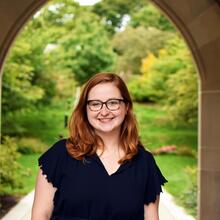I’m 9. From the moment I open my eyes one Sunday in 2007, I’m buzzing with anticipation. As an older sibling, roping my little sister into my schemes and plans is one of my talents; so very soon, the contagion of that frenetic energy has spread from me to her. Our joint excitement fills our pink-walled room, and then follows us at lightning speed as we rush down the stairs.
“Good morning, girls,” our mom greets us. She acts like she doesn’t notice the pleading looks on our faces, like she has no idea what we’re about to ask her. Of course, she does.
“Can we?”
“You know what our tradition is. We wait until dinner.”
“Please!”
“A tradition’s a tradition. We’ll light the wreath and be together, and then you can open them.”
We mope and groan, and we go through this routine a few more times before we accept her decision, but the day is filled with a kind of waiting that feels expectant, hopeful. Almost like magic.
•••
Each year, since the very first year of my life, my mother has given me a small gift on the Sundays of Advent.
Each Sunday, we would come to the dinner table as a family, light the Advent wreath and read a prayer that would remind us of that Sunday’s special meaning. Then we would open our gifts and enjoy them.
It is probably my most precious family tradition. It’s not only the source of so many happy childhood memories, but it has also been a thread that has carried me through transition times when I felt shaky and unmoored.
Even though I’m an adult now and I live in another state, my mother will mail me my presents weekly during Advent. Because she wants to make sure that they are never late, sometimes they arrive a few days early. I always have to make a promise that I’ll wait to open it, not just until Sunday but until we can gather over FaceTime in the evening to light the Advent wreath together virtually.
•••
It’s 2020, and I’m 22. I work in a midtown Manhattan office, where I’m wearing a mask over my mouth and nose, surrounded by just two or three coworkers. The Covid-19 pandemic has claimed thousands of lives, and the vaccine is still months away for the general public. I’m excited to live in New York City, but every step outside my apartment feels fraught, risky. And though I don’t admit it to anyone but myself, the cold and bitter onset of winter is making it impossible to ignore: I’m lonely.
Suddenly, an email comes through. It’s from my apartment building manager, and he’s letting me know that there’s a package waiting for me when I get home. Behind my mask, I smile. I had almost forgotten.
My mom texts: “I got a notification that your package was delivered. You know what to do. DON’T open until Sunday night.”
Into my mask, I let out a sigh of relief. So much is uncertain these days, but thank God this tradition remains.
•••
Over the years, I’ve tried to get to the bottom of how this tradition originated. I’ve asked my mother: Did she read about it in a book somewhere? Did her family do it when she was a little girl? The answer to these questions is always no, and while I know many other Catholic families who gather to light their Advent wreaths, I’ve never heard of the gift tradition anywhere else.
My mom always says that she wanted to mark the season of Advent for us from the very beginning, to teach us that our faith observes a special season in advance of Christmas Day. But when she’s grilled about where the details of the idea came from, she has an almost maddeningly simple answer: “I just thought it up.”
I have never lost the strong sense of hope, reflection and presence that I associate with Advent.
The older I get, the more I feel and the more I hear from my peers that “Christmas just doesn’t feel like Christmas anymore.” When we graduate from Santa Claus and no longer see Christmas magic through the eyes of a child, the holidays can feel like a gigantic letdown. And while I have felt a nagging sadness that Christmas will never seem quite as magical as it did when I was young, I have never lost the strong sense of hope, reflection and presence that I associate with Advent. I believe that’s the real gift my mother gave to me.
•••
Now, let’s address a critique: Why is an Advent tradition a reason for kids to get more “stuff”? After all, Christmas consumerism is such a powerful force in our culture already, and the emphasis on material goods doesn’t exactly reflect the humble, sacred story at the center of the holiday. If you hope your family learns the holy waiting and preparation of Advent, why teach them that by buying them more gifts?
As Christians, we are taught to be suspicious of this worldly desire for stuff, this cultural tendency toward overconsumption—and rightly so. In observing my mom’s work on this Advent tradition, though, I am convinced of this: Gift-giving can be a holy practice. Because the core of our tradition is not really about the item being exchanged, at least not primarily.
My mother is known by friends and family as an excellent gift-giver. I believe it’s because her gifts are personalized, thoughtful, almost tailor-made. The Advent gifts are small things, not the top-ticket items on our Christmas lists. Most of the time, they’re things I never knew I might want or like, or even things I never knew existed. And yet, when my sister and I open them and see what’s in the other’s box, the reaction is usually: “That is so you.” It’s perfect.
Gift-giving is a tradition most of us participate in, especially at this time of year. Why not treat it like a holy practice? It is not about items, it’s about relationships. Your gift can show someone you really know them, that you’ve really paid attention to what makes them tick.
•••
I’m 24. It is the fourth and final Sunday of Advent in 2022, and I’ve already traveled home to be with my family for the holidays, and my sister is home from college. That means we’re not just observing our favorite tradition virtually from three different states; it’s around our kitchen table, just like old times.
I’ll be honest: I don’t remember what the gift was on that Sunday. Christmas pajamas? A book? A sweet treat? It could have been any of these.
I do have a vivid memory of one moment though.
Looking at my mother’s face, I sense the joy of the giver.
I hear my sister laughing. I see the warm light of the wreath’s candles. My mom is sitting at her unofficially designated seat at the table, beholding us and smiling.
I’m old enough now to appreciate that she is the source of this specialness, this whimsy, this warmth. The “magic” of the Christmas season, the kind that we experience in childhood, seems like it comes to us out of nowhere. Now I understand it is delivered by the hard work, dedicated care and abiding love of the people who look after us.
For a couple of decades, I’ve felt the joy of being the recipient of this tradition. Looking at my mother’s face, I sense the joy of the giver.
The Christmas miracle came to us in the form of a person. Maybe the graces of this Advent season are little reflections of that miracle, given to us by people, too.
•••
As you read this, Advent has begun; and if you’re reading this on a Sunday evening, I may very well be continuing this tradition with my family right now via FaceTime. With 25 years of the tradition under my belt, I can identify some of its fruits in my life. The fact that I am now a grown adult who lives away from my family but will still do this means something. The fact that I look forward to passing this on to my own children one day means something. Regardless of the gifts, of the items themselves, this tradition has been habit-forming. It’s been the kind of habit that has, with practice, begun to feel really good. It’s a process of letting yourself sit in the anticipation, in that expectant waiting for the ultimate good thing. These are things I am now in the practice of giving to myself, because our family’s tradition has taught me how much richness can be added to one’s life by virtue of holy anticipation.
How blessed am I to have a mom whose love is creative. Whose love is personal. Whose love drives her to create a seasonal tradition all our own. Whose love lies in the passing on of something not just fun and memorable but also sacred.
How blessed am I that we share a sense, a sense she gave to me, that this time of year is something that deserves our attention, our observance, our gathering. That it is right and just to rejoice, to share time with loved ones, to return to our treasured practices over and over again. That’s the gift. Now is the time to give it.








